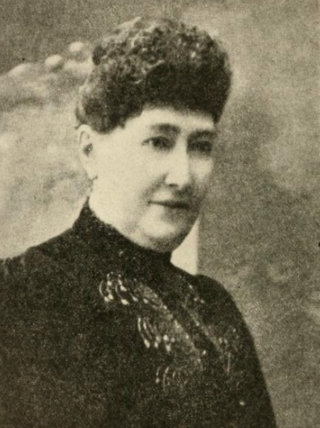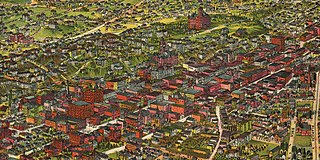
Coyoacán is a borough in Mexico City. The former village is now the borough's "historic center". The name comes from Nahuatl and most likely means "place of coyotes", when the Aztecs named a pre-Hispanic village on the southern shore of Lake Texcoco dominated by the Tepanec people. Against Aztec domination, these people allied with the Spanish, who used the area as a headquarters during the Spanish conquest of the Aztec Empire and made it the first capital of New Spain between 1521 and 1523.

Downtown Los Angeles (DTLA) contains the central business district of Los Angeles. In addition, it contains a diverse residential area of some 85,000 people, and covers 5.84 sq mi (15.1 km2). A 2013 study found that the district is home to over 500,000 jobs. It is also part of Central Los Angeles.

Olvera Street, commonly known by its Spanish name Calle Olvera, is a historic pedestrian street in El Pueblo de Los Ángeles, the historic center of Los Angeles. The street is located off of the Plaza de Los Ángeles, the oldest plaza in California, which served as the center of the city life through the Spanish and Mexican eras into the early American era, following the Conquest of California.
The culture of Los Angeles is rich with arts and ethnically diverse. The greater Los Angeles metro area has several notable art museums including the Los Angeles County Museum of Art (LACMA), the J. Paul Getty Museum on the Santa Monica Mountains overlooking the Pacific, the Museum of Contemporary Art (MOCA), and the Hammer Museum. In the 1920s and 1930s Will Durant and Ariel Durant, Arnold Schoenberg and other intellectuals were the representatives of culture, in addition to the movie writers and directors. As the city flourished financially in the middle of the 20th century, culture followed. Boosters such as Dorothy Buffum Chandler and other philanthropists raised funds for the establishment of art museums, music centers and theaters. Today, the Southland cultural scene is as complex, sophisticated and varied as any in the world.

The Ávila Adobe, built in 1818 by Francisco Ávila, is the oldest standing residence in the city of Los Angeles, California. Avila Adobe is located in the paseo of historic Olvera Street, a part of the Los Angeles Plaza Historic District, a California State Historic Park. The building itself is registered as California Historical Landmark #145, while the entire historic district is both listed on the National Register of Historic Places and as a Los Angeles Historic-Cultural Monument.

La Iglesia de Nuestra Señora la Reina de los Ángeles is a historic Catholic church in Los Angeles, California, located on the historic Plaza de Los Ángeles near Downtown Los Angeles. Part of the larger El Pueblo de los Ángeles Historical Monument, the church's origins date to 1784, when the Spanish founded the Nuestra Señora Reina de los Ángeles Asistencia to support nearby Mission San Gabriel Arcángel. By 1814, the asistencia had been abandoned and a new church was founded in its place by Padre Luis Gil y Taboada. The church is one of the oldest buildings in Los Angeles.
Dan Kwong is an American performance artist, writer, teacher and visual artist. He has been presenting his solo performances since 1989, often drawing upon his own life experiences to explore personal, historical, and social issues.

The historic center of Mexico City, also known as Centro or Centro Histórico, is the central neighborhood in Mexico City, Mexico, focused on Zócalo or main plaza and extending in all directions for a number of blocks, with its farthest extent being west to the Mexico City Alameda Central. The Zocalo is the largest plaza in Latin America. It can hold up to nearly 100,000 people.

El Pueblo de Los Ángeles Historical Monument, also known as Los Angeles Plaza Historic District and formerly known as El Pueblo de Los Ángeles State Historic Park, is a historic district taking in the oldest section of Los Angeles, known for many years as El Pueblo de Nuestra Señora la Reina de los Ángeles del Río de Porciúncula. The district, centered on the old plaza, was the city's center under Spanish (1781–1821), Mexican (1821–1847), and United States rule through most of the 19th century. The 44-acre park area was designated a state historic monument in 1953 and listed on the National Register of Historic Places in 1972.

The Plaza Substation was an electrical substation that formed a part of the "Yellow Car" streetcar system operated by the Los Angeles Railway from the early 1900s until 1963. After being threatened with demolition in the 1970s, the Plaza Substation was added to the National Register of Historic Places in 1978.
Main Street is a major north–south thoroughfare in Los Angeles, California. It serves as the east–west postal divider for the city and the county as well.
Margi Scharff was an American artist. Among her better known pieces were The Night Room, Pillar of Warmth and A Series of Miscellaneous Connections. Scharff was given to using found objects in her art.

Pershing Square is a small public park in Downtown Los Angeles, California, one square block in size, bounded by 5th Street to the north, 6th Street to the south, Hill Street to the east, and Olive Street to the west. Originally dedicated in 1866 by Mayor Cristóbal Aguilar as La Plaza Abaja, the square has had numerous names over the years until it was finally dedicated in honor of General John J. Pershing in 1918.

The Museo Soumaya is a private museum in Mexico City and a non-profit cultural institution with two museum buildings in Mexico City — Plaza Carso and Plaza Loreto. It has over 66,000 works from 30 centuries of art including sculptures from Pre-Hispanic Mesoamerica, 19th- and 20th-century Mexican art and an extensive repertoire of works by European old masters and masters of modern western art such as Auguste Rodin, Salvador Dalí, Bartolomé Esteban Murillo and Tintoretto. It is called one of the most complete collections of its kind.

Grand Avenue is a major north–south thoroughfare in Los Angeles, California. Lined with museums, concert venues, and theaters, this urban center on Bunker Hill attracts millions of people a year. Grand Park stretches between the Los Angeles City Hall and the Los Angeles Music Center on Grand Avenue. In 2007, a $3 billion Grand Avenue Project was proposed to revive Downtown Los Angeles.

Gloria Molina Grand Park, commonly known as Grand Park, is a 12-acre (4.9 ha) park located in the civic center of Los Angeles, California. First developed in 1966 as the 'Civic Center Mall' with plazas, fountains and a Court of Flags, it is now a part of the larger redevelopment known as the Grand Avenue Project, with its first phase having opened in July 2012. Grand Park is part of a joint venture by the city of Los Angeles and Los Angeles County. It was designed and built by the Los-Angeles-based multidisciplinary design firm Rios Clementi Hale Studios. Park programming and entertainment, security and upkeep are maintained by the nearby Los Angeles Music Center.

Doria Deighton-Jones was a Scottish-born American landowner and property developer in Los Angeles who built a "vast estate in and around" the city while the city was in its infancy.

The late-Victorian-era Downtown of Los Angeles in 1880 was centered at the southern end of the Los Angeles Plaza area, and over the next two decades, it extended south and west along Main Street, Spring Street, and Broadway towards Third Street. Most of the 19th-century buildings no longer exist, surviving only in the Plaza area or south of Second Street. The rest were demolished to make way for the Civic Center district with City Hall, numerous courthouses, and other municipal, county, state and federal buildings, and Times Mirror Square. This article covers that area, between the Plaza, 3rd St., Los Angeles St., and Broadway, during the period 1880 through the period of demolition (1920s–1950s).
















